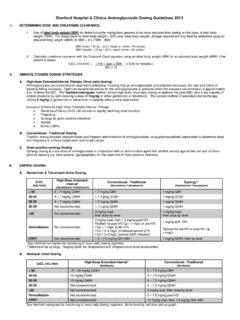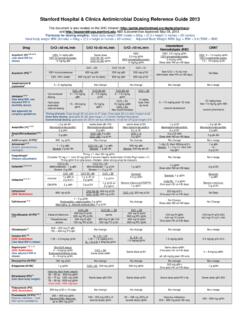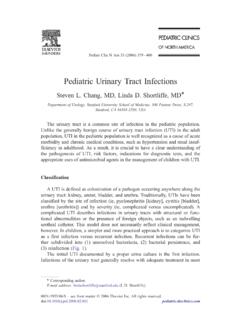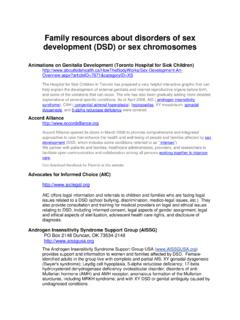Transcription of TYPE 2 DIABETES ADULT OUTPATIENT INSULIN GUIDELINES
1 Page 1 of 5. This product may be reproduced with the citation: Developed by the DIABETES Coalition of California, October 2010 See Web site ( ) for the latest version and disclaimer. BASAL INSULIN Intermediate-acting: NPH Note: NPH INSULIN has elevated risk of hypoglycemia so use with extra caution6,8,15,17,25,32 Long-acting: Glargine (Lantus ) Detemir (Levemir ) Basal INSULIN is best starting INSULIN choice for most patients (if fasting glucose above goal). 6,7,8 Start one of the intermediate-acting or long-acting insulins listed above. 6,7 Start INSULIN at night. 8 When starting basal INSULIN : Continue secretagogues.
2 Continue metformin. 7,8,20,29 Note: if NPH causes nocturnal hypoglycemia, consider switching NPH to long-acting INSULIN . 17,25,32 TYPE 2 DIABETES ADULT OUTPATIENT INSULIN GUIDELINESIf post-meal glucose levels > 180: ADD PRANDIAL INSULIN6,7,8 Note: If patient unable to do multiple daily injections, consider switching to MIXED INSULIN instead of adding prandial INSULIN . (Mixed INSULIN is more likely to cause hypoglycemia8,19 and generally requires a fixed meal schedule8) TITRATE: Teach patient to self titrate by 2 units every 2-3 days until average fasting glucose < 130*6,7,8,13,14,30,32 (*Inform patient to hold titration until further evaluation if develops any hypoglycemia) or Titrate 1-2 times per week such as per table below until average fasting glucose < 1306,19 Fasting glucose > 200 4 units Fasting glucose 131-200 2 units Fasting glucose 70-130 No change in dose Fasting glucose < 70 2-4 units or by 10% STARTING DOSE: Start dose.
3 10 units6,7,8,11,12,13,14,16,19,20,21,22,25 Consider using a lower starting dose (such as units/kg/day32) especially if patient is thin or has a fasting glucose only minimally above ,19 GENERAL RECOMMENDATIONS Start INSULIN if A1C and glucose levels are above goal despite optimal use of other DIABETES medications. (Consider INSULIN as initial therapy if A1C very high, such as > ) 6,7,8 Start with BASAL INSULIN for most patients 6,7,8 Consider the following goals1,6 ADA A1C Goals: A1C < for most patients A1C > (consider ) for higher risk patients 1. History of severe hypoglycemia 2. Multiple co-morbid conditions 3. Long standing DIABETES 4. Limited life expectancy 5.
4 Advanced complications or 6. Difficult to control despite use of INSULIN ADA Glucose Goals*: Fasting and premeal glucose < 130 Peak post-meal glucose (1-2 hours after meal) < 180 Difference between premeal and post-meal glucose < 50 *for higher risk patients individualize glucose goals in order to avoid hypoglycemia Once fasting glucose at goal, evaluate post-meal glucose pattern6,7,8 DIABETES Coalition of California TITRATE Adjust INSULIN to carb ratio as appropriate per below until post-meal glucose <1807,34 1 unit to 15 gm 1 unit to 12 gm 1 unit to 10 gm 1 unit to 7 gm 1 unit to 5 gm 1 unit to 4 gm 1 unit to 3 gm Alternate adjustment: Adjust INSULIN to carb ratio per 500 rule7 Alternate choice7,34 if meals vary in size and patient is accurate at counting carbs TYPE 2 DIABETES ADULT OUTPATIENT INSULIN GUIDELINES PRANDIAL INSULIN Short Acting: Regular Note: Regular INSULIN has longer peak and extra risk of hypoglycemia so use with caution6,8,33 Rapid Acting: Lispro (Humalog ) Aspart (Novolog ) Glulisine (Apidra ) Add prandial INSULIN to basal INSULIN if post-meal blood glucose levels are above ,7,8 Start one of the prandial insulins listed above.
5 6,7 When adding prandial INSULIN : Stop secretagogues. Continue metformin. Continue basal INSULIN (may need to re-adjust dose).6,7,8 Rapid acting insulins should be just before meal. Short acting INSULIN needs to be taken 30 minute before ,7 Note: after maximizing prandial and night-time basal INSULIN dose, may need to consider adding a morning dose of basal INSULIN if pre-dinner glucose remains above goal (more likely to be necessary if using NPH) 18,19,26,28,30 TITRATE: Titrate1-2 units every 2-3 days until post-meal glucose < 1806,8,34,35 (May consider different doses for different meals) STARTING DOSE: PRE-DINNER dose 6-10 units40,43,45,50 (may adjust depending on previous basal INSULIN dose42,51) Target glucose for titration is fasting glucose.
6 8,43,45,46,53 (may also consider post-dinner glucose when titrating dose) STARTING DOSE: PRE-BREAKFAST dose: 6-10 units40,43,45,50 (may adjust depending on previous basal INSULIN dose42,51) Target glucose for titration is pre-dinner glucose. 8,43,45,46,53 (may also consider post-breakfast glucose when titrating dose)TITRATE: Titrate1-2 units every 2-3 days until average target glucose <13043,51 OR Titrate 1-2 times per week such as per table below until average target glucose <13043 Target glucose >200 by 4 units Target glucose 131-200 by 2 units Target glucose 70-130 No change Target glucose < 70 2-4 units or by 10% May require different doses for pre-breakfast and pre-dinner May consider adding pre-lunch dose as well if needed42,53 MIXED INSULIN 70/30 NPH/Regular Note.
7 70/30 NPH/Regular INSULIN has elevated risk of hypoglycemia so use with extra caution6,8 75/25 Lispro Mix (Humalog Mix) or 50/50 Lispro Mix (Humalog Mix) 70/30 Aspart Mix (Novolog Mix) Mixed INSULIN is an option for patients who are unable to do multiple injections and who have fixed meal Mixed INSULIN is more likely to cause hypoglycemia compared to basal and prandial ,19 Start one of the mixed insulins listed above. When adding mixed INSULIN : Stop secretagogues. Continue metformin. Stop all other insulins. 7,8 If post-meal pattern high Move down the scale Page 2 of 5. This product may be reproduced with the citation: Developed by the DIABETES Coalition of California, October 2010 See Web site ( ) for the latest version and disclaimer.
8 If post-meal pattern low Back up the scale Consider adding pre-meal Correction Factor (CF)7: Add 1 unit for each 50 that pre-meal glucose is > 130 Alternative method to determine pre-meal correction factor: Correction factor (CF) = 1800 / total daily dose of INSULIN (1800 rule) STARTING DOSE: 4 units qAC6,35,36,37 May consider start with largest meal only6,7 Instruct patients to eat carb consistent meals when first starting prandial INSULIN Alternative dose: 7-10% of basal INSULIN dose qAC7,8,36 Consider adding pre-meal Correction Factor (CF)7: Add 1 unit for each 50 that pre-meal glucose is > 130 Alternative method to determine pre-meal correction factor: Correction factor (CF) = 1800 / total daily dose of INSULIN (1800 rule)ALTERNATE STARTING CHOICE: 1 unit to 15 grams carbs qAC34 Note: may consider calculate INSULIN to carb (I:C) ratio = 500 / total daily dose (TDD) of INSULIN (500 rule)7 DIABETES Coalition of California ADDITIONAL INFORMATION: Alternate self titration for basal insulin16: May consider self titrating basal INSULIN by increasing dose 1 unit every day until average fasting glucose is < 130, if that is easier for the patient to understand.
9 Self titration of small doses may be easiest for patients using INSULIN pens. Other DIABETES medication in combination with insulin6,7,8,20,24,29 Metformin Continue if able because helps prevent weight gain when patient on INSULIN Secretagogues: (sulfonylureas and meglitinides): Consider continuing when patient is on basal INSULIN only. Stop when patient is on prandial or mixed INSULIN . Other DIABETES Medications: decision to continue or discontinue other DIABETES medications should be made with consideration of multiple individual patient characteristics. Note: once patient s glucose levels are controlled with INSULIN , it may occasionally be possible to stop INSULIN and continue or switch to oral medications depending of the stage of the DIABETES and changes in other individual patient ,7,8 Example of correction factor using 1800 Rule7 Patient on 60 units basal INSULIN .
10 Total Daily Dose (TDD) is 60 units. Correction Factor (CF) = 1800 / 60 = 30. If pre-meal glucose = 250, blood glucose is 150 mg/dl above goal of 100; Correction is 150/30 = 5 units. Give 5 units in addition to prandial INSULIN dose being used to cover meal. Example of carbohydrate ratio using 500 Rule7 Patient on 50 units basal INSULIN daily. Total Daily Dose (TDD) is 50 units. INSULIN to Carbohydrate Ratio (I:C Ratio): 500/50 = 1:10 units. For a 60 gm carbohydrate meal = 60/10 = take 6 units. Example of INSULIN with prandial starting dose of 4 units and correction factor of 1:50 Pre-meal Glucose Level Prandial INSULIN Dose 70-150 4 units 150-200 5 units 200-250 6 units 250-300 7 units 300-350 8 units











